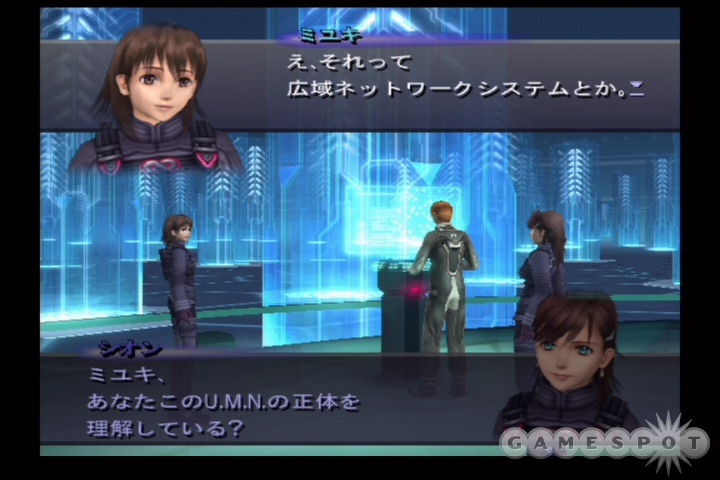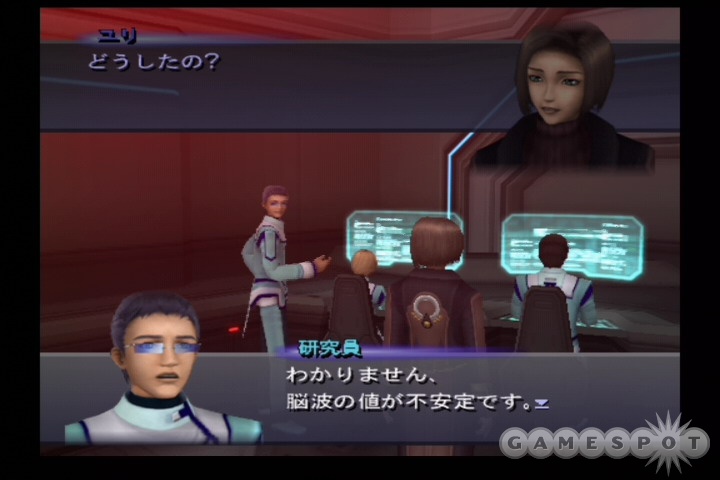Xenosaga Episode III: Also Sprach Zarathustra Import Hands-On
We get our hands on a finished Japanese-language version of the third and final game in Monolith Soft's popular RPG series.
Currently scheduled for release in North America toward the end of August, Xenosaga Episode III: Also Sprach Zarathustra is the last game in Monolith Soft's popular Xenosaga trilogy, which debuted in Japan back in 2002. We recently acquired a Japanese-language version of the new game from Hong Kong (which comes bundled with brief instructions in English and Chinese) and have played through the first five or six hours in order to bring you our impressions. The first thing you need to know about Xenosaga Episode III: Also Sprach Zarathustra is that, even with the benefit of the aforementioned instructions sheet, the story-driven game is very text-heavy and, as such, isn't a game that you should be rushing out to import unless you have a good understanding of the Japanese language (which this author doesn't) or no interest in its storyline. 
In Xenosaga III you'll reprise the role of Shion, a young engineer whose tragic past includes losing both of her parents as a child and, more recently, the untimely death of her fiancé. Shion and many of the other key characters will be familiar to you if you're a fan of the series, but it seems unlikely that knowledge of the previous games will be necessary to enjoy this one. Xenosaga Episode III: Also Sprach Zarathustra kicks off with a tutorial of sorts, which tasks you with negotiating the puzzle-filled rooms and corridors of a building that, at one point, is referred to as S-Division. There are lots of inanimate objects to blow up and lots of highly impractical door mechanisms to figure out as you progress through the level, but regardless of whether or not you understand Japanese, you'll emerge from the experience with a good understanding of the game's basic controls.
Many of the environments in the early stages of the game have a virtual-reality feel about them, and are even a little reminiscent of the movie Tron in places. As you progress through these areas and solve puzzles you'll occasionally be confronted by hovering robots, at which point exploration takes a back seat and you're thrust into a turn-based character battle along with up to two other members of your party. The order in which each combatant gets to take their first turn is determined by their respective agility ratings, which when facing off against the robots at the beginning of the game invariably means that your entire party will get to launch an attack before the enemies have a chance to respond. Depending on your characters' status and the circumstances of the fight, you'll have up to eight combat options available to you every time your turn comes around. In addition to the requisite attack, item, and escape commands, you'll be able to expend ether points (the game's equivalent of magic energy or mana) to perform special attacks or use powerful ether techniques, guard or evade until your character's next turn, swap out one of your active characters for a reserve, or, if your boost count is charged up, perform a deathblow attack. All of the combat options are in Japanese, but they're not terribly difficult to figure out with some trial and error.
Some of the different attacks in Xenosaga Episode III: Also Sprach Zarathustra fall into one of five categories: physical, beam, lightning, ice, or fire. The effectiveness of these attacks will depend on the target's affinity with them, so while some attacks will be good for 150 percent of their usual damage, for example, others can actually restore health to the target. Another thing to watch out for during combat is status changes, which generally occur as a result of special attacks. The most common status change during our time with the game was Break, which prevents the afflicted character from acting for two turns. Other status changes will include Poison, which depletes 20 percent of the character's health each turn; Damage Reverberation, which causes the character to sustain the same amount of damage that they dish out; Heat, which causes all enemies to focus their attacks on the same character; and various afflictions that reduce character attributes or prevent them from using certain techniques. The combat that we've experienced thus far hasn't been particularly challenging, and even the boss that took us several minutes to defeat never really threatened to kill anyone in our party; that's unlikely to be the case later on, though.
In addition to character battles, Xenosaga Episode III: Also Sprach Zarathustra features E.S. battles, which are those that occur when your characters are piloting powerful "Ein Sof" mechs. We've only played through two or three E.S. battles at this point, and what's clear is that although they're visually more impressive than those contested by characters on foot, the gameplay is a lot more simplistic. There are fewer attack options when you're in an E.S. mech, but the tradeoff is that it's possible to chain together attacks for increased damage. Joint assaults in which multiple members of your group all attack as part of the same turn are also possible, although these occur automatically rather than as the result of a specific command. 
Although we experienced a decent amount of combat during our first couple of hours with Xenosaga Episode III: Also Sprach Zarathustra, the game slowed down quite considerably after that, and we've spent much of our remaining time with the game simply exploring futuristic environments, shopping for items and equipment, and clicking our way through lots of very lengthy conversations. In one sequence that would no doubt have been quite interesting if we understood Japanese, we clicked through conversations spanning a visit to a beach, a black-and-white flashback scene, and characters on a space station and multiple spaceships without ever getting to do anything else. Quite how long the whole thing lasted is difficult to say, and while it amounted to little more than an exercise in frustration on this occasion, we're very interested to find out what was being said once we get our hands on an English-language version of the game--which pretty much sums up our entire experience. Xenosaga Episode III: Also Sprach Zarathustra is a promising game that fans of the series are no doubt eager to get their hands on, and which doesn't appear to be too difficult to play through with little knowledge of the language. The Xenosaga series is best known for its excellent storytelling, though, so beating the game without being able to understand the voice acting or subtitles is unlikely to do it justice.
Got a news tip or want to contact us directly? Email news@gamespot.com
Join the conversation